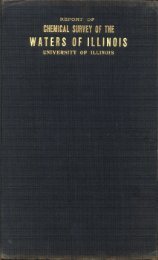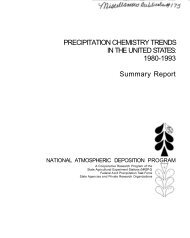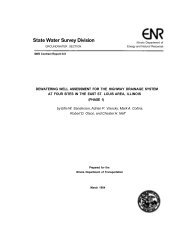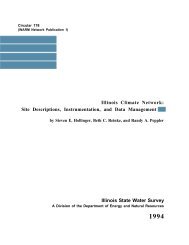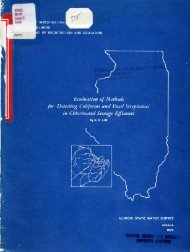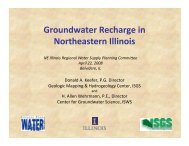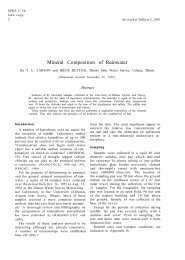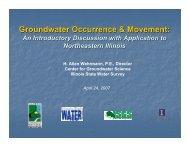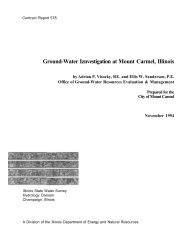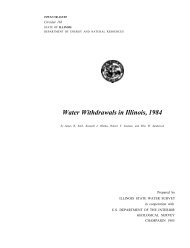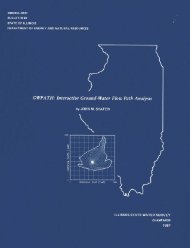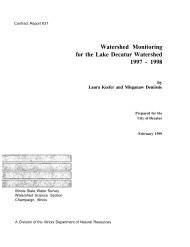Ground-water development in East St. Louis area, Illinois. Urbana, IL ...
Ground-water development in East St. Louis area, Illinois. Urbana, IL ...
Ground-water development in East St. Louis area, Illinois. Urbana, IL ...
Create successful ePaper yourself
Turn your PDF publications into a flip-book with our unique Google optimized e-Paper software.
<strong>in</strong> which the well is operated dur<strong>in</strong>g three successive<br />
and equal time periods at constant fractions of full capacity.<br />
<strong>St</strong>ep-drawdown test data are available for n<strong>in</strong>e wells<br />
<strong>in</strong> the <strong>East</strong> <strong>St</strong>. <strong>Louis</strong> <strong>area</strong>. The results of the step-drawdown<br />
tests and construction features of the wells tested<br />
are given <strong>in</strong> table 14. Well-loss constants for wells<br />
tested immediately after construction range from 0.2<br />
to 1.0 sec 2 /ft 5 .<br />
Specific-capacity data collected dur<strong>in</strong>g well-production<br />
tests made on 32 <strong>in</strong>dustrial, municipal, and irrigation<br />
wells are given <strong>in</strong> table 15. The well-production tests<br />
consisted of pump<strong>in</strong>g a well at a constant rate and frequently<br />
measur<strong>in</strong>g the drawdown <strong>in</strong> the pumped well.<br />
Drawdowns were commonly measured with an airl<strong>in</strong>e,<br />
electric dropl<strong>in</strong>e, or steel tape; rates of pump<strong>in</strong>g were<br />
largely measured by means of a circular orifice at the end<br />
of the pump discharge pipe.<br />
The lengths of tests ranged from 11 m<strong>in</strong>utes to 2<br />
days; pump<strong>in</strong>g rates ranged from 104 to 1905 gpm.<br />
Screen diameters ranged from 8 to 32 <strong>in</strong>ches.<br />
Specific-capacity data for 65 selected relief wells are<br />
given <strong>in</strong> table 16. The wells were tested dur<strong>in</strong>g the period<br />
1952 through 1960 by the U.S. Corps of Eng<strong>in</strong>eers.<br />
The saturated thickness of the aquifer at well sites was<br />
estimated from logs of wells and <strong>water</strong>-level data. The<br />
tests consisted of pump<strong>in</strong>g the wells at a constant rate of<br />
500 gpm for 2 hours and frequently measur<strong>in</strong>g the drawdown<br />
<strong>in</strong> the pumped well.<br />
A coefficient of storage <strong>in</strong> the <strong>water</strong>-table range<br />
(0.10) estimated from aquifer-test data and several<br />
values of t and r w were used (see Walton 1962) to determ<strong>in</strong>e<br />
the relationship between specific capacity and<br />
the coefficient of transmissibility for various values of<br />
r w 2 /t (figure 22). Specific capacities, data concern<strong>in</strong>g<br />
the lengths of tests and radii of wells <strong>in</strong> tables 15 and<br />
16, and figure 23 were used to estimate theoretical coefficients<br />
of transmissibility of the aquifer with<strong>in</strong> the<br />
cones of depression of production wells. Theoretical<br />
coefficients of permeability with<strong>in</strong> the cones of depression<br />
were estimated by divid<strong>in</strong>g the coefficient of transmissibility<br />
by the average saturated thickness of the<br />
aquifer with<strong>in</strong> cones of depression The average saturated<br />
thickness of the aquifer with<strong>in</strong> cones of depression<br />
was estimated from logs of wells and <strong>water</strong>-level data.<br />
No great accuracy is implied for the coefficients of<br />
permeabilities estimated from specific-capacity data because<br />
they are based on an estimated coefficient of storage<br />
and are not corrected for well-loss and partial penetration<br />
losses. However, as shown <strong>in</strong> table 14, well-loss<br />
constants for most newly constructed wells are small.<br />
Most wells penetrate completely the more permeable parts<br />
of the aquifer. Thus, well and partial penetration losses<br />
were probably small and not significant. The data <strong>in</strong><br />
tables 15 and 16 can be considered only rough approximations<br />
of the coefficient of permeability of the aquifer.<br />
However, the coefficients of permeability <strong>in</strong> the Monsanto<br />
<strong>area</strong> estimated from specific-capacity data agree<br />
closely with the coefficients of permeability computed<br />
from aquifer tests at the Mobil Oil Ref<strong>in</strong>ery and the Monsanto<br />
Chemical Corporation, <strong>in</strong>dicat<strong>in</strong>g that the estimated<br />
coefficients of permeability are mean<strong>in</strong>gful.<br />
Water-level and pumpage data for exist<strong>in</strong>g pump<strong>in</strong>g<br />
centers were used to compute pump<strong>in</strong>g center specific<br />
capacities given <strong>in</strong> table 17. Pump<strong>in</strong>g center specific capacity<br />
is here def<strong>in</strong>ed as the total pumpage from wells<br />
with<strong>in</strong> the pump<strong>in</strong>g center per foot of average drawdown<br />
with<strong>in</strong> the pump<strong>in</strong>g center.<br />
Summary of Aquifer-Test Data<br />
A map show<strong>in</strong>g how the coefficient of permeability<br />
varies with<strong>in</strong> the <strong>East</strong> <strong>St</strong>. <strong>Louis</strong> <strong>area</strong> (figure 23) was<br />
Owner<br />
Mobil Oil Co.<br />
Screen<br />
length<br />
Driller<br />
(ft)<br />
Luhr Bros. 36<br />
Table 14. Results of <strong>St</strong>ep-■Drawdown Tests<br />
Screen<br />
diameter<br />
f<strong>in</strong>)<br />
16<br />
Screen Material<br />
Johnson Everdur<br />
No. 50 slot<br />
Date<br />
well<br />
drilled<br />
12/59<br />
Date<br />
of<br />
test<br />
Well-loss<br />
constant<br />
(sec 2 /ft 5 )<br />
10/61 2.0<br />
Southwestern Layne-Western 20 10 Slotted pipe 11/60 12/60 0.2<br />
Campus of SIU,<br />
Edwardsville<br />
Coll<strong>in</strong>sville (V) Layne-Western 30 16 Layne No. 4 slot 8/50 8/50 0.7<br />
Thomason Thorpe 32 X 40 Porous concrete 5/54 5/54 0.2<br />
Amos Bonham Thorpe 30 X 40 Porous concrete 10/54 4/55 0.45<br />
Herbert Bischoff Thorpe 60 30 X 40 Porous concrete 1/54 5/54 0.5<br />
V. W. Eckmann Thorpe 48 30 X 40 Porous concrete 9/54 10/54 1.0<br />
<strong>East</strong> <strong>St</strong>. <strong>Louis</strong> Luhr Bros. Wood 4/55 5/55 1.0<br />
Dra<strong>in</strong>age Dist.<br />
<strong>East</strong> <strong>St</strong>. <strong>Louis</strong> Luhr Bros. Wood 4/55 5/55 1.0<br />
Dra<strong>in</strong>age Dist.<br />
22



